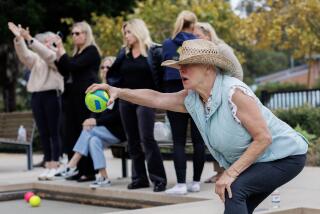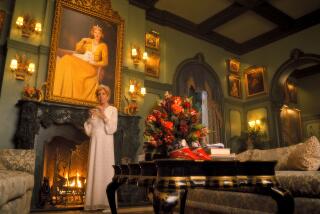Scratch Those Seedy Pool Halls; Upscale Parlors Are Running the Table
- Share via
TURTLE CREEK, Pa. — Pool shark Denny Ayers longs for the good ol’ days when players threw punches and swung cue sticks like Louisville Sluggers, when hustlers cleaned out the wallets of suckers and toughs broke fingers of losers who didn’t pay.
“I used to stamp out my cigarette butts on the floor,” Ayers was saying the other day at Pinky’s, a venerable pool hall in this gritty mill town just outside Pittsburgh. “The atmosphere was different. It was smoky. It was better.”
It also was a cancer that sent that sort of pool hall to its grave a decade ago. Now, pool has shed its shady reputation, become “pocket billiards,” and has returned with a cleaned-up act.
Upscale pool parlors have popped up across the land, some in peculiar places. There’s one in Nemacolin Woodlands, a resort at the foot of western Pennsylvania’s Laurel Mountain. Fancy parlors are on Sunset Strip in Hollywood, in fashionable areas of Cape Cod and in the heart of Manhattan.
At Nemacolin, you can get a facial in the spa, play an afternoon round of golf, a few racks of eight-ball before dinner, then have a bath in a Jacuzzi.
It’s a setting far removed from the dreary and menacing pool halls Minnesota Fats hustled in decades ago. Back then, wagers ranged into the thousands of dollars. Matches went on for days. The windows were stained with grime.
These ‘90s pool halls are different. There is stained glass--similar to church windows. There are brass rails, tuxedoed bartenders, soft music, evening gowns.
And no gambling.
“It is a yuppie activity, wholesome activity, young activity . . . a clean co-ed activity,” says Mike Shamos, a Pittsburgh lawyer and pool buff. Shamos began collecting billiards memorabilia in the ‘80s, figuring that the sport had died.
Today, the Billiards Congress of America says about 90% of billiards players in the United States shoot pocket billiards, commonly known as pool. The rest play snooker, which requires a bigger table, smaller pockets and more balls; or carom, with fewer balls and no pockets.
The Billiards Congress says at least 50% more people play billiards than golf or tennis.
“The one thing about pool is that you can play it anytime,” says Sam Lucciola, a player at Shootz, an upscale pool parlor and restaurant on Pittsburgh’s South Side.
Shamos is a transplanted New Yorker. He grew up playing pool at McGirr’s, a basement parlor at 45th Street and 8th Avenue near Times Square, where the smoke hung like fog over the green-felt tables.
McGirr’s is no longer. In its day it was the consummate pool parlor, like the one Fast Eddie Felson and Minnesota Fats worked in “The Hustler.” Paul Newman played the youthful Felson and Jackie Gleason the seasoned Fats. They dueled in a marathon match in which thousands of dollars changed hands.
Similar games took place at Pinky’s, where Ayers started out racking balls for players 28 years ago, when he was 12.
“I was the guy who ran for hamburgers and coffee,” Ayers said. “They’d play for days.”
People could walk into such places with a wad of cash and walk out with crippled hands and empty pockets.
“These were really dangerous places,” Shamos says. “Guys would get knifed. People would fight with pool cues. There was always a bookie in the room and probably a drug dealer or two.
“There was a time when respectable people--even if they loved the game--wouldn’t want to be playing pool in public because they would have been associated with a lowlife crowd.”
Now pool is used as a backdrop for advertisements, a clue that society has a forgiving memory.
In fact, billiards has practically turned into a family sport. Classic Billiards in South Yarmouth, Mass., on Cape Cod, has 13 tables and shortened cue sticks for kids.
In California, the Hollywood Athletic Club on Sunset Strip has 45 tables, a bar and grill and plenty of celebrity patrons like Charlie Sheen and Kiefer Sutherland.
In these places, people play for fun. The owners are happy to provide the atmosphere, as long as the players keep coming back and renting the tables for about $10 an hour.
Lucciola was playing for fun recently with a buddy at Shootz, where 18 tables flank dinner tables. The atmosphere was comfortable: leather sofas, fireplace, happy-hour buffet and bright lighting.
“You don’t have to worry about getting shot outside,” said Lucciola, 29, a salesman who plays about three times a week during the winter.
One of the game’s top female pros, Swedish-born Ewa Mataya, was at Nemacolin recently for a trick-shot demonstration. In her view, people are attracted to pool because of its many varieties.
“Like golf, people who play pool get hooked on it,” Mataya says.
The most popular variation of pocket billiards is eight-ball. Players call shots and must sink seven balls before ultimately sinking the black eight-ball to win.
One game growing in popularity is the quicker-paced nine-ball. On each shot, the first ball struck must be the lowest-numbered ball among nine. The player that sinks the nine wins.
“The Color of Money,” Martin Scorsese’s 1986 sequel of sorts to “The Hustler,” had plenty of nine-ball scenes with Newman as an older Felson and Tom Cruise as his protege. The movie no doubt helped revitalize interest in the game.
Nine-ball has replaced straight pool as the game played in most tournaments. Straight pool, in which a player must make 150 balls to win, was the game Newman played against Gleason in “The Hustler.”
Historians say billiards is centuries old and probably has its roots in England, where it started as an offshoot of lawn bowling. The lawn bowlers of the 14th Century became tired of rain delays, went indoors, and in time raised the game from the floor to tables with pockets cut into their sides to substitute for wickets.
The French word billiard means “bent stick,” which applied to the curved cue sticks used at the time.
One early ambassador of the game was Louis XIV of France. He issued challenges far and wide for subjects to come forth and play him.
Today’s players are a mixed group. Studies conducted in 1991 by the Billiard & Bowling Institute of America showed that the number of players from households with a collective income of $50,000 or more had jumped 84% since 1987.
The study showed that 38.8 million people played billiards at least once during 1990. A third of that group were women, who in the old days stayed away from seedy pool halls.
Billiards trailed only bowling (53.5 million) and basketball (39.8 million), the study said. Other sports thought to be popular pastimes trailed miserably. The study showed 24.5 million played golf and 21.7 million played tennis.
If there’s one drawback to these new high-rent pool parlors, Shamos says, it’s that the owners aren’t pool players.
“You go to a pool hall looking for a lesson and they look at you funny,” Shamos says. “That’s because they are restaurateurs, not pool players.”
More to Read
Go beyond the scoreboard
Get the latest on L.A.'s teams in the daily Sports Report newsletter.
You may occasionally receive promotional content from the Los Angeles Times.










